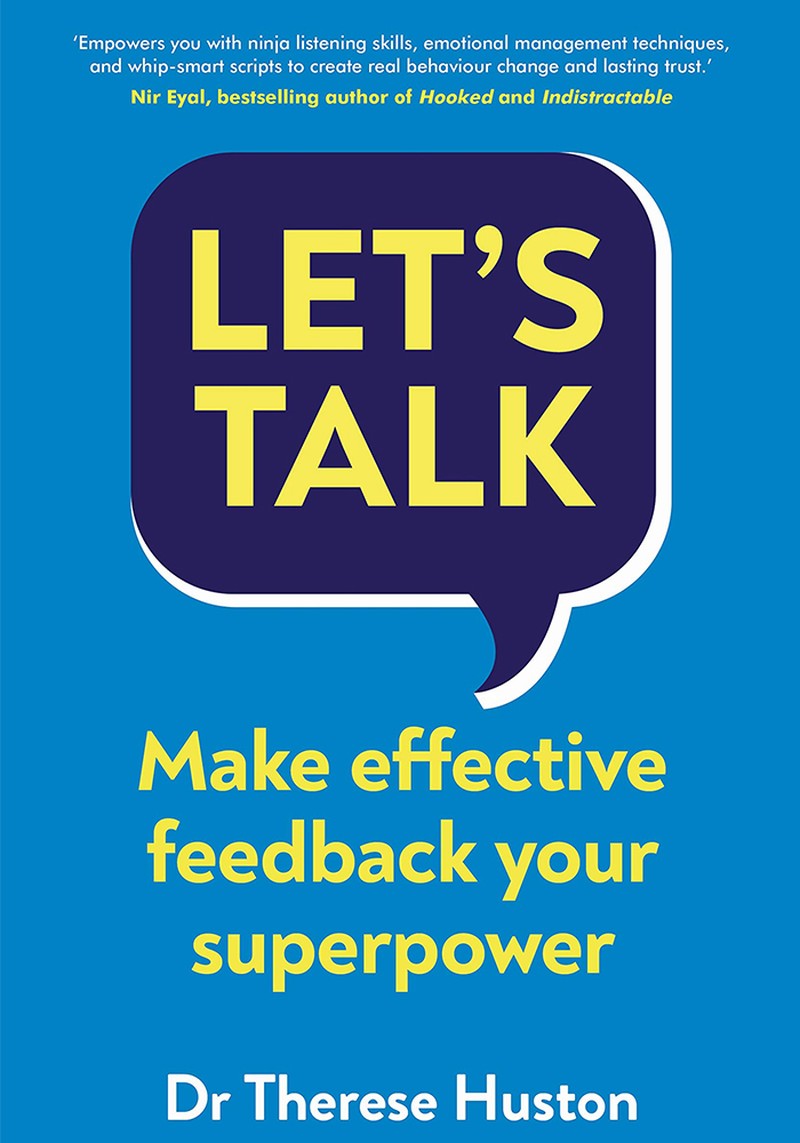
The Power Of Giving & Receiving Constructive Feedback
First, why is feedback such a difficult topic?
For Therese, the main reason many people find feedback such a difficult topic to broach is that many of us don’t receive any or adequate training before we’re expected to deliver it. “Chances are you walk into that professional situation alone, with little or no training and no team to guide you. The only simulations you’ve run, if any, were all in your head and amounted to ‘Is there some way to say this so he won’t get upset?’” And while many people might argue giving constructive feedback isn’t rocket science, Therese claims it’s actually harder. “If you’re a rocket scientist, you’ll have years of formal training and focused simulations and risk-free brainstorming with a whiteboard and whip-smart team before anyone even lets you in the same building with a rocket.”
Is feedback harder to hear or harder to give?
According to Therese, while it’s never a nice experience hearing negative feedback, it can be even harder for the manager to deliver it. “Feedback is hard for managers. One national study found that more than one-third (37%) of managers are uncomfortable giving employees critical feedback, and managers I’ve interviewed think that number is grossly underreported. A common misconception about feedback is that it’s stressful only for the person receiving it. Yet when researchers ask employees to rate how stressful their organisation’s evaluation process is, the senior employees giving feedback report significantly higher stress levels than the junior people receiving it.”
Feedback is everywhere these days – online, on social media – so why is it so hard to give in a work context?
Therese agrees – in many ways, she says, it should be easier to give feedback today than it was ten years ago, but there’s nothing quite like being one-on-one to make the experience completely awkward. “We’ve become a society that offers feedback everywhere we go. We leave reviews of restaurants we loved and Airbnb apartments we hated. London Heathrow airport even asks passengers to rate the dreaded security lines with the press of a button. Despite all the practice we have giving feedback publicly, however, when it’s time to give feedback privately, human to human, we find ourselves ill-equipped. There’s no magic button.”
So, what’s the problem?
“An obvious part of the problem is that giving feedback to people on your team is personal,” says Therese. “You know nothing about the executive chef behind your meal or the security guard behind the scanner, but you do know Emily. You hired her. You know she has a daughter and is finishing a degree. You also know she’s easily discouraged, and you can’t find the heart to tell her she’s woefully underperforming.”
But that’s not the only issue, says Therese. “Managers are also reluctant to give feedback because it creates a lot of work.” By this, she means managers have to issue new goals, set up new check-in sessions and monitor whether their charge is taking the advice on board. Plus, there’s far more pressure from corporate HR these days to check in with employees more often. “Millennials want feedback more often than the workers they’re replacing. Then there’s Gen Z, born 1996 or later. At a time when Gen Z employees are just entering the workforce, it’s hard to understand their appetite for feedback, but early research indicates your new hires will prioritise their own professional development above all else.”
Do you think the way we look at feedback has to change?
“If we’re going to revolutionise feedback and meet the demands coming from all sides, we need a radical rethink,” argues Therese. “The old system of ‘don’t say anything unless you have something nice to say’ stopped working ages ago, and much to the dismay of everyone who is conflict avoidant, we can’t just have these difficult conversations in our heads. We need to have them with other people and if they’re going to be worth your time and theirs, we need them to work.”
In the book, feedback is likened to being a ‘superpower’ – tell us more…
“It’s true: giving feedback can become your superpower,” explains Therese. “It’s one of the rare skills you can develop where every improvement translates into better outcomes for your whole team. Boost your feedback skills a little, and employees will come to work more motivated. Boost your feedback skills a lot, and people will say you’re the best boss they’ve ever hard and this was some of the best work they’ve ever done.” According to Therese, good feedback is the missing link between good workers and serious outperformers. “Feedback can be the lever that turns your average performers into you hardest workers and your stars into superstars. Researchers find that average performers can be powerfully motivated by evidence they’re making progress. Small wins mean a lot.”
But wait – does telling hard-working people they’re doing well actually make a difference?
According to Therese, yes. “Top performers have different needs. Managers often assume superstars see their impact and don’t need encouragement. Rock stars, they reason, rise above all that.” But research shows the opposite might be true. “If anything, superstars want more feedback and hope for a serious sit-down feedback conversation at least once a month,” says Therese. And yet, only around half of them do. “They might need your help on their soft skills. It doesn’t mean you’re thrust into the role of full-time therapist. Nor do you have to be as smart as your superstars to help them. Ask the right questions and you’ll make everyone better.”
So how do you give feedback that actually works?
According to Therese, there are two main camps people fall into. “In the one camp, we have visionaries who believe feedback needs to be radically more direct, that challenging people is key. The other camp takes the opposite view on how to give feedback. Visionaries in this camp insist that challenging directly leads not to excellence but to disgruntled employees.” As for what Therese thinks, she believes something is missing from both approaches. “Radical transparency doesn’t work for everyone – not everyone relishes having their mistakes laid bare. But the other approach also feels extreme. As managers, there are times when we need to discuss problematic behaviours and we need tools for doing so. The philosophy of ‘care personally’ and ‘challenge directly’ is the most balanced, and I can see how it would be ideal when done skilfully, even though it takes high emotional intelligence to get it right.”
Emotional intelligence must be key, right?
“Most of us think we have higher emotional intelligence (sometimes referred to as EQ) than we actually possess,” warns Therese. “For instance, 95% of us think we have high self-awareness, when research shows only 10-15% of us do.” It is realistic, she says, to therefore press forward assuming managers will rely on their emotional intelligence to steer them through tricky situations. “We need an approach that’s fool-proof, that won’t lead droves of people to quit and that gives managers strategies for addressing problems, not just strengths and that doesn’t require high EQ.”
What kind of damage is done by poorly delivered feedback?
In her experience, Therese says it’s unlikely people stay discouraged only for a couple of days before bouncing back from poorly delivered feedback. “Some do, but in my research on employees’ most demotivating feedback experiences, more than 38% feel disengaged and demotivated at work for over a month, a handful more than a year.” What’s worse, statistics show that when feedback leaves employees feeling demotivated, disappointed or depressed, four out of five actively or passively end up looking for another job.
So how do you make feedback work for everyone?
In short, says Therese, make it a two-way conversation. “First, people want their hard work acknowledged. They also want a chance to provide their side of the story. When it’s feedback time, it turns out we want a good listener more than we want a good talker. Research finds that if employees think you’re a good listener they also think you’re better at giving feedback.” Therese adds, when you dig into examples of good feedback, you’ll often see it comes down to two people engaging in a conversation. “It’s not one person telling someone what’s good or what’s bad, it’s two people talking. What I hear again and again in successful feedback conversations is that they were actual conversations in which two people talked and those same two people listened.”
What kind of role does unconscious bias play?
“Research has consistently found that managers of all genders tend to give woman less effective coaching than men,” admits Therese. “If you think highly of your women colleagues, or if you’re a woman yourself, the notion you would offer men superior feedback is downright insulting.” According to Therese, it’s more common for women to receive feedback about their personality and communication style, as a result of unconscious bias. “One team of researchers searched employees’ actual written performance reviews for the word “aggressive”. They found 76% of the time it appeared, it was in a woman’s file and only 24% of the time it was in a man’s.” The findings suggest it’s a word seen as a compliment for men, but an insult for women.
“There’s also growing evidence of racial bias in feedback,” adds Therese. “At the moment it’s less well documented than gender bias, but we tend to focus on different traits when we’re evaluating Black, Latinx and Asian employees than when we’re evaluating white employees. We don’t mean to prioritise different criteria, but unless we’re mindful, we do.”
So, finally, what other themes or ideas does the book explore?
“While part one introduces four fundamental principles that help you give more effective feedback, the goal is to change how you think about feedback, so you create a more productive space.” In this section, Therese explores the three main definitions of feedback: appreciation, coaching and evaluation – proving there’s no need to split feedback into simply positive or negative.
“Appreciation is what most of us call positive feedback, praise or recognition. On the surface, appreciation is about the work. When you express appreciation, you’re acknowledging how an employee’s behaviours, efforts and personal qualities benefit the work and the team. At a surface level, it’s about reinforcing that behaviour.” Coaching, on the other hand, is feedback which should help the person adapt and grow. “At its simplest, coaching is advice and at its most complex, transformation. Some managers shy away from coaching because it sounds like too much work, but coaching can be as simple as checking in after a key meeting, contribution or milestone and asking two or three helpful questions.” Finally, evaluation as feedback lets the other person know where they stand. “It might be a ranking, a rating or a comparison to peers,” explains Therese. “Sometimes it’s very concrete – perhaps you have to rate every employee on a scale of one to five – and sometimes it’s fuzzy.” Regardless, Therese argues a combination of all three is the most effective tactic, and any feedback conversation should include at least two of these principles.
“Then, part two is your toolbox, in which I unpack the six key practices. These are play-by-play tactics, giving examples of what different conversations might look like, what kind of resistance to expect and how to navigate it – plus, what to say if you’re thrown a curve ball.”
‘Let’s Talk: Make Effective Feedback Your Superpower’ is out now, available at Waterstones.com.
DISCLAIMER: We endeavour to always credit the correct original source of every image we use. If you think a credit may be incorrect, please contact us at info@sheerluxe.com.


